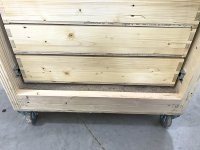I am just finishing my sharpening station and decided that this small cabinet - 20" depth x 30" width x 32" height - needed some ballast to give it some mass. My thinking is that because it will not be attached to a wall it will need to be heavy to withstand the normal stress associated with sharpening. The rear wheels are fixed and the front wheels rotate and lock.
My Tormek will sit on the left side of the top, the other side will be used to place the water/oil/diamond stone that I will be using when sharpening my tool.
View attachment 1View attachment 2
Below the last drawer there is a 2-3/4" high cavity and I filled it will two bags of playground sand. Each bag claimed to be 50 lbs which theoretically gives me 100 lbs of ballast. While this is all well and good (so far ...) a little voice in my head keeps telling me that I'm overlooking something. I've racked my brain for several days and cannot think of any reason why this is not a good idea.
One thought did come to my mind and that is the possiblity of water getting into the sand somehow. I'm sloppy, but not that sloppy. Any water that may accidentily get in there could come from the Tormek's water trough, but that's a real stretch. The top will be 1" melamine and I plan to add a 3/4" x 1"(ht) splash guard all around the edge of the melamine top, so there'd have to be really huge water spill to flow over that. That's just is not going to happen.
Another possibility is insects taking up residence in the sand. I could sprinkle some lime over the sand and that would probably discourage any freeloaders.
Anyway, if anyone has some thoughts on this I would love to hear them.
Thanks!
My Tormek will sit on the left side of the top, the other side will be used to place the water/oil/diamond stone that I will be using when sharpening my tool.
View attachment 1View attachment 2
Below the last drawer there is a 2-3/4" high cavity and I filled it will two bags of playground sand. Each bag claimed to be 50 lbs which theoretically gives me 100 lbs of ballast. While this is all well and good (so far ...) a little voice in my head keeps telling me that I'm overlooking something. I've racked my brain for several days and cannot think of any reason why this is not a good idea.
One thought did come to my mind and that is the possiblity of water getting into the sand somehow. I'm sloppy, but not that sloppy. Any water that may accidentily get in there could come from the Tormek's water trough, but that's a real stretch. The top will be 1" melamine and I plan to add a 3/4" x 1"(ht) splash guard all around the edge of the melamine top, so there'd have to be really huge water spill to flow over that. That's just is not going to happen.
Another possibility is insects taking up residence in the sand. I could sprinkle some lime over the sand and that would probably discourage any freeloaders.
Anyway, if anyone has some thoughts on this I would love to hear them.
Thanks!



